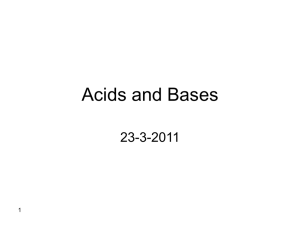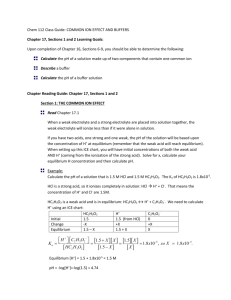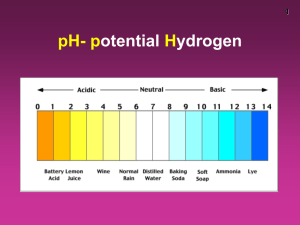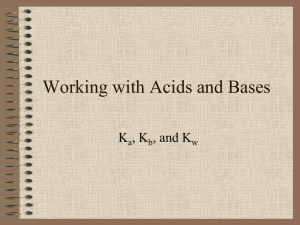ChemQuest 71
advertisement
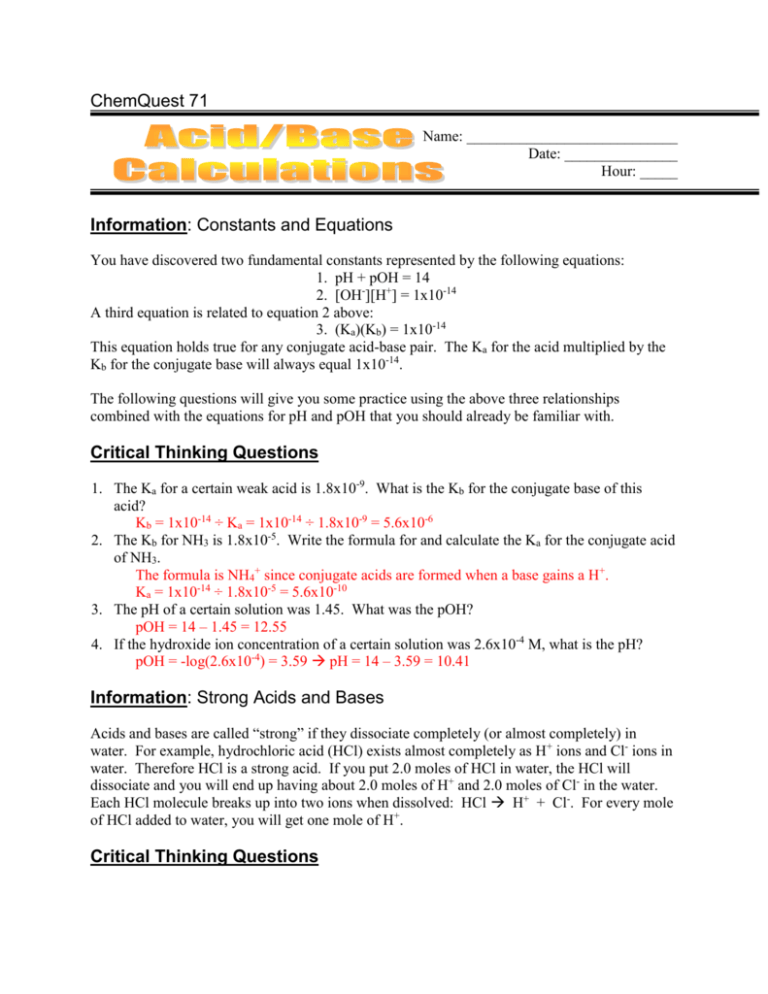
ChemQuest 71 Name: ____________________________ Date: _______________ Hour: _____ Information: Constants and Equations You have discovered two fundamental constants represented by the following equations: 1. pH + pOH = 14 2. [OH-][H+] = 1x10-14 A third equation is related to equation 2 above: 3. (Ka)(Kb) = 1x10-14 This equation holds true for any conjugate acid-base pair. The Ka for the acid multiplied by the Kb for the conjugate base will always equal 1x10-14. The following questions will give you some practice using the above three relationships combined with the equations for pH and pOH that you should already be familiar with. Critical Thinking Questions 1. The Ka for a certain weak acid is 1.8x10-9. What is the Kb for the conjugate base of this acid? Kb = 1x10-14 ÷ Ka = 1x10-14 ÷ 1.8x10-9 = 5.6x10-6 2. The Kb for NH3 is 1.8x10-5. Write the formula for and calculate the Ka for the conjugate acid of NH3. The formula is NH4+ since conjugate acids are formed when a base gains a H+. Ka = 1x10-14 ÷ 1.8x10-5 = 5.6x10-10 3. The pH of a certain solution was 1.45. What was the pOH? pOH = 14 – 1.45 = 12.55 4. If the hydroxide ion concentration of a certain solution was 2.6x10-4 M, what is the pH? pOH = -log(2.6x10-4) = 3.59 pH = 14 – 3.59 = 10.41 Information: Strong Acids and Bases Acids and bases are called “strong” if they dissociate completely (or almost completely) in water. For example, hydrochloric acid (HCl) exists almost completely as H+ ions and Cl- ions in water. Therefore HCl is a strong acid. If you put 2.0 moles of HCl in water, the HCl will dissociate and you will end up having about 2.0 moles of H+ and 2.0 moles of Cl- in the water. Each HCl molecule breaks up into two ions when dissolved: HCl H+ + Cl-. For every mole of HCl added to water, you will get one mole of H+. Critical Thinking Questions 5. Consider a strong acid like HCl. If the concentration of the acid is 0.025 M, what is the concentration of hydrogen ions? Explain your reasoning. 0.025 M because all of the HCl breaks up into H+ and Cl- ions. 6. Consider a strong base such as NaOH. If the concentration of the base is 0.75 M, what is the concentration of the hydroxide ions? Explain. For a strong base, [OH-] = [base]. Therefore, here the [OH-] = 0.75 M 7. What is the pH of a solution that has a concentration of HCl equal to 0.0049 M? [H+] = [HCl] = [0.0049]; pH = -log(0.0049) = 2.31 8. If 2.5 moles of HCl were dissolved in 42 L of water, what would the pH be? What would the pOH be? [H+] = [HCl] = 2.5mol ÷ 42L = 0.595 M pH = -log(0.595) = 0.23 pOH = 14 – 0.23 = 13.77 9. The strong base, NaOH, was dissolved in water. If 4.2 moles of NaOH was dissolved in 245 L of water, what is the pH of the solution? [OH-] = [NaOH] = 4.2mol ÷ 245L = 0.017 M; pOH = -log(0.017) = 1.77 pH = 14 – 1.77 = 12.23 Information: Weak Acids and Bases Weak acids and bases do not dissociate completely in water. For example, consider acetic acid (HC2H3O2): HC2H3O2 H+ + C2H3O2- ; Ka = 1.7x10-5 For HCl, the concentration of HCl equaled the concentration of H+ so finding the pH was easy. However, for acetic acid, [HC2H3O2] does not equal [H+] because not all of the HC2H3O2 dissociates into H+ ions. To find the pH of a solution of acetic acid, you first must calculate the [H+] using the Ka. This will be an equilibrium problem! Once you know [H+], you calculate pH using pH = -log[H+]. Critical Thinking Questions 10. What is the pH of a solution that was 0.75 M acetic acid? (Note: 0.75 M is the initial concentration of acetic acid.) a) Find the equilibrium concentration of H+ using the equilibrium constant, Ka, as shown below. Recall that [C2H3O2-] and [H+] will equal “x” and [HC2H3O2] will equal 0.75-x. [C H O - ][H ] Ka 2 3 2 [HC 2 H 3 O 2 ] 1.7 x10 5 [x ][ x] x2 5 1.7 x10 x 0.036 [ H ] [0.75 - x] 0.75 b) Now that you know the equilibrium concentration of H+, calculate the pH. pH = -log(0.036) = 2.45 11. Find the pH of a 0.85 M solution of hydrocyanic acid, HCN, whose Ka = 4.9x10-10. pH = 4.69 [CN-][H+] Ka = (x)(x) = [HCN] (0.85-x) x2 4.9x10 -10 x = 2.04x10-5 = [H+] = 0.85 pH = -log(2.04x10-5) = 4.69 12. Find the pH of a 0.5 M solution of ammonia, NH3, whose Kb is 1.8x10-5. pH = 11.48 [NH4+][OH-] (x)(x) 1.8x10-5 = Kb = [NH3] pOH = -log(0.003) = 2.52 pH = 14 – 2.52 = 11.48 x = 0.003 M = [OH-] (0.5 – x)
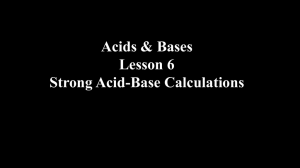
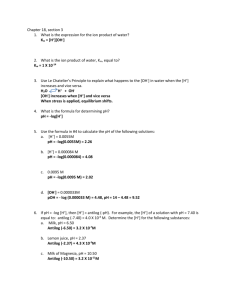
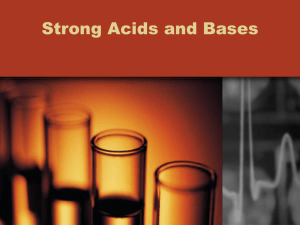

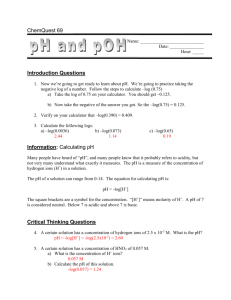
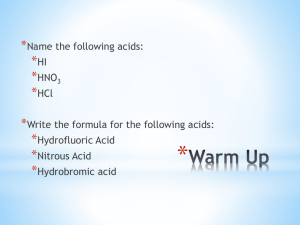
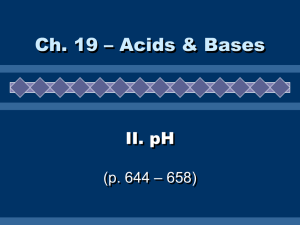
![1. Find the pH of 0.1 M HClO4 This is a strong acid, so [H ] = 0.1 M](http://s3.studylib.net/store/data/008121755_1-338138652fc42091377fe33aaddd7c71-300x300.png)
